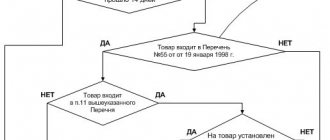How to resolve the issue pre-trial
Any information that pre-trial protection of consumer rights is mandatory is only partly true. The Law “On the Protection of Consumer Rights” adopted in Russia does not provide for mandatory out-of-court settlement of disputes arising with the seller. The exception to this are two situations: when it comes to a dispute with a telecom operator or with a carrier, including regarding the transportation of baggage or cargo. In these situations, you first need to try to resolve the issue out of court; in other cases, the consumer has the right to file a statement of claim in court.
In practice, it is better to first try to resolve the issue with the seller of goods or services, without resorting to the help of a court. Most Russian companies protect their reputation and try to meet the consumer halfway by finding a compromise solution, but within the framework of current legislation.
How to write a complaint
To launch a mechanism for solving the problem out of court, you need to file a pre-trial claim for the protection of consumer rights. The document does not have a strictly established form, but it must contain the following information:
- data of the addressee and contacts of the applicant indicated in the header of the claim;
- a detailed description of the purchased product or service provided, regarding the quality of which there was dissatisfaction;
- date of purchase of goods (provision of services), cost;
- the essence of the claim in free form;
- requirements for the seller, taking into account current legislation (it may be mentioned that in case of refusal to satisfy the requirements, the consumer reserves the right to appeal to the court or Rospotrebnadzor);
- listing of documents if they are sent along with the claim (warranty card, check, etc.).
You can download sample claims on the Rospotrebnadzor website, but it is better to entrust this issue to a lawyer who can state the essence of the claim as accurately as possible and confirm their legality with appropriate references to the laws.
Pre-trial procedure for protecting consumer rights
The claim is drawn up in two copies. The first document is sent to the head of the organization where the consumer was served. This can be done by leaving the document with the seller, secretary or other authorized person. On the second claim, the employee must put a date of receipt and signature, as well as certify it with a seal. The second copy remains in the hands of the consumer. If an employee refuses to accept a claim, it must be sent by registered mail with notification to the head of the organization.
The claim is reviewed by the company's management and must receive a response in writing within ten days. The document must contain information about whether the consumer's requirements will be satisfied and, if so, in what form. The seller is responsible for refusing to satisfy a claim; this is provided for in the “On the Protection of Consumer Rights”.
If the seller refuses to satisfy the consumer’s requirements or the option offered by the company does not suit the buyer, you can safely file a claim in court. The same reaction should occur if the claim has not been considered within ten days and the consumer has not received an appropriate written response.
Most often, it is beneficial for the consumer to resolve the dispute out of court. Consult with a lawyer to understand how high the chance of achieving the desired result is and how best to proceed. Our specialists will draw up a claim and tell you where to go if the answer is unsatisfactory.
When the seller is obliged to pay compensation for moral damages
The defendant is obliged to execute the court decision himself, including the collection of compensation for moral damage. However, such cases are rare. To get money, you need to contact the bailiffs, or submit a writ of execution to the debtor's bank. It is important that the amount of the penalty for violation of consumer rights is accrued for the entire period before the fulfillment of obligations. This rule does not apply to compensation for moral damage, so it will not be possible to index or increase the amount. You can also read about how to submit an application to bailiffs to collect a debt in our previous material.
Appeal to the consumer court
If the issue of violation of consumer rights cannot be resolved out of court, you will have to go to court. There are also a number of nuances that you need to be aware of. The Supreme Court has issued a ruling relating to consumer protection and regulating the judicial review of civil cases. Let us dwell only on some important points for the consumer.
Jurisdiction
The task of the consumer protection court is to carefully consider the claim and make a decision on it in favor of the plaintiff or defendant. To initiate legal proceedings, you need to have an understanding of jurisdiction.
In accordance with Art. 17 of Law No. 2300-1, the consumer can independently choose where to send the statement of claim geographically: at his place of residence, at the location of the seller or at the place of the transaction. In this case, the following principles are often adhered to:
- if the defendant is an individual entrepreneur, then the claim is sent to his place of residence;
- if the defendant is a legal entity, then the document is sent to the court at the place of the company’s legal address;
- if it is difficult to attend a court hearing of a claim in another city, then the claim is filed at the plaintiff’s place of residence.
If the defendant is a legal entity with several branches and consumer rights were violated in one of them, he can file a claim at the location of this branch, regardless of the territorial location of the main office.
As for the choice between the magistrate and district court, it depends on the requirements of the plaintiff. The cost of the claim also affects the amount of money that the plaintiff demands to recover from the defendant. This may take into account the cost of the purchased product or service, penalties and losses incurred by the consumer due to the sale of low-quality goods or negligent provision of services. Moral damage is not included in the cost of the claim.
According to paragraph 5 of Art. 23 of the Code of Civil Procedure of the Russian Federation, if the value of the claim is less than 50,000 rubles, a statement of claim must be filed in the magistrate’s court. If the amount of recovery from the defendant is more than this amount, then the claim is sent to the district court.
A number of requirements that the magistrate cannot consider:
- the plaintiff’s demands are not of a property nature (he asks to eliminate defects without returning the cost of services provided);
- it is impossible to estimate the value of the claims;
- among the requirements there is a mention of compensation for moral damage.
A statement of claim with such requirements should be sent to the district court.
How does the consumer protection court work?
The first thing you need to do is consult with a lawyer about drawing up a statement of claim in court for the protection of consumer rights. It must comply with the norms of the Code of Civil Procedure of the Russian Federation and not have ambiguous wording.
Contents of the claim:
- address and name of the court;
- details of the plaintiff and defendant;
- the essence of the problem (there may be circumstances of purchase, complaints about the quality of goods or services, information about the cost of the transaction and other information);
- information about the procedure for out-of-court resolution of the problem, if there was one (here you can indicate the dates of filing the claims, the company’s response to them);
- references to laws confirming the legitimacy of the requirements;
- the requirement is to return the goods, return its cost, terminate the contract, compensate for moral damages, compensate for damages, etc.;
- list of attached documents.
At the conclusion, the plaintiff signs and dates it. The statement of claim is sent to the court according to jurisdiction. If the interests of the consumer are represented in court by another person, information about him must be indicated in the statement of claim. A power of attorney certified by a notary is also attached to it.
The statement of claim will be considered at a court hearing, the date and time of which the plaintiff will receive appropriate notification. During the trial, the court will consider all the circumstances of the case and carefully study the plaintiff’s evidence, including:
- expert opinions;
- witness statements;
- documents (response to a claim, purchase and sale agreement or provision of services, etc.);
- explanations from each side;
- video and audio materials.
At the end of the meeting, a court decision will be made to protect consumer rights or to reject claims. An oral explanation will also be given regarding the decision and the time frame for appealing it. Copies of the court decision will be sent to the parties within five days after the court decision is made.
The most difficult thing to win is if the defendant is a bank, a car dealer, or a medical organization. But even if the defendant’s field of activity is different, there is a risk of losing the trial. Therefore, it is advisable to hire a lawyer who will help at all stages: from collecting evidence and drawing up a statement of claim to representing the interests of the plaintiff in court. This approach increases the chances of success.
Filing a claim in court
A claim for moral damage is submitted in free form. The main thing is that the document contains the following information:
- name of the court>;
- information about the plaintiff : full name, address, telephone;
- information about the defendant : name, address;
- main part : a story about the problem, but it would be better to refer to the legislation.
- evidentiary part>;
- a request to the court indicating the desired amount of compensation;
- list of attached documents>;
- date and signature.
Penalties and fines for violation of consumer rights
The consumer has the right to indicate in the statement of claim requirements for payment of a penalty. It is calculated on the date of filing the claim. However, the plaintiff still has the opportunity to recalculate the penalty as of the date of the court decision. If the defendant refuses to pay, the plaintiff has the right to file a separate lawsuit to recover the lost funds.
The amount of the penalty is usually determined by the relevant law or an agreement previously concluded between the seller and the consumer. Otherwise, 1% of the amount of claims is taken into account, as defined in Article 23 of Law No. 2300-1. Under shared construction agreements, a special rate is provided for calculating penalties. So, if the developer violated the delivery deadlines or failed to eliminate defects that arose through his fault on time, he will have to pay a penalty in the amount of 1/150 of the Central Bank rate for each day of delay.
There are many difficulties in determining the amount of penalties for consumer protection issues. To solve them, you need the presence of a lawyer during the trial of the case. Citizens who refuse legal assistance are more likely to lose their cases.
Arbitrage practice
Consumers often expect compensation. But the courts do not always satisfy such requirements or approve them partially.
Examples:
- The plaintiff claimed compensation in connection with poor quality services at the trampoline park in the amount of 1 million rubles. The judge refused due to lack of proof of the cause-and-effect relationship (case No. 2-390/2018 of the Moskovsky District Court of St. Petersburg).
- The plaintiff made a claim from the insurance contract in the amount of 100,000 rubles. 5,000 rubles were collected. (case No. 2-1163/2018 in Samara).
- The plaintiff made demands from relations for routine repairs of the property of an apartment building in the amount of 40,000 rubles. 500 rubles collected. (case No. 2-2-2/2018 in Tver).
- The plaintiff claimed from the purchase and sale agreement in the amount of 5,000 rubles. Result of recovery of 1,000 rubles. (case No. 2-1187/2017 in Penza).
Procedure for considering a claim
Claims for moral damage are considered by court districts of general jurisdiction at the place of residence (registration) of the defendant or at the place of residence of the plaintiff in cases of harm to health.
The court considers the claim in the following order:
- determines the nature of the relationship between the plaintiff and the defendant;
- identifies grounds (evidence) for compensation and then considers them;
- determines the degree of guilt of the defendant;
- determines the amount of damage caused by the plaintiff.
Returning goods legally
Return of a product of proper quality is possible if its presentation and consumer properties are preserved, as well as if there is a document confirming the fact and conditions of purchase of the specified product. And then the sellers begin to demand a receipt.
However, the consumer’s lack of a document confirming the fact and conditions of purchase of the goods does not deprive him of the opportunity to refer to other evidence of the purchase of goods from this seller, i.e. It is not necessary to present a receipt; it is enough to prove that the product was purchased in your store, for example, with a corresponding tag on the product.
The buyer has the right to refuse the goods at any time before its transfer, and after the transfer of the goods - within 7 days.
If the consumer requests a refund, the seller must return the amount that the consumer paid for the product and for the delivery of this product.
In this case, the consumer's expenses for returning the goods are not reimbursed.
Again using an example.
A consumer bought a laptop bag, paid 6,300 for the bag, and 850 rubles for delivery by courier. The bag arrived on time, but the laptop did not fit into it, and the consumer decided to return it. I sent it back to the seller by Russian Post for 430 rubles. Total consumer expenses are 7580 rubles.
The seller must return 6300+850=7150 rubles. 430 rubles – expenses for returning the goods, which are not subject to reimbursement by the seller. In total, both the consumer and the seller will bear the costs of delivering the goods - each their own. By the way, the seller must make a return no later than 10 days from the date of presentation of the consumer’s demand. This is the next rule to remember.
Rule 6. The return of goods must be made no later than 10 days from the date of presentation of the demand, including compensation for delivery of the goods to the consumer
It is worth talking about another interesting article of the law. Article 14 states:
“The right to demand compensation for damage caused as a result of defects in a product (work, service) is recognized for any victim, regardless of whether he was in a contractual relationship with the seller (performer) or not.”
Another example. Now there will be a long and confusing story, brace yourself.
Let's say you are installing windows. And they installed a plastic window in Marya Ivanovna’s kitchen. After some time, Marya Ivanovna sold this apartment, and with it the window, to Sergei Anatolyevich.
Svetlana, a neighbor of Sergei Anatolyevich (and previously Marya Ivanovna), parked her car under this window. And then suddenly part of the glass fell out and damaged Sveta’s car.
In this case, Svetlana (and Sergei Anatolyevich too) can call Marya Ivanovna, find out who installed this ill-fated window, and demand compensation for damage from your company, although the contract you had was not concluded with them at all. Something like this…
This leads to the following rule:
Rule 7. Any victim can demand compensation for damage, even without a contract
Let's look further at distance selling and the information posted on the website.
Let's see how all of the above pages are implemented in large stores, for example, Eldorado:
On the M.Video website:
How to demand compensation from a seller or performer
To receive compensation for moral damage, you must first contact the seller with a written claim in free form. Try:
- be convincing in justifying compensation;
- the amount of moral damage should not be presented too high;
- encourage the seller to maintain his high image;
- hint about your desire to settle the matter peacefully, without going to Rosportebnadzor and the courts;
- don't be rude, be extremely polite.
If the seller is a small organization or individual entrepreneur, then such claims are considered by the manager himself. You should contact him personally - this will be valid.
If you are dealing with huge organizations (for example, chain hypermarkets), then such a number will not work with them, since they have strict rules on how to resolve such disputes. They mainly focus on judicial resolution of conflict.
Sometimes a claim for moral damages is used to persuade the underlying claim to be granted. Let’s say the consumer does not want long disputes and court proceedings, then a formidable claim with a large amount of moral damage is written to the seller and a compromise is immediately offered - “... in the event of voluntary satisfaction of the main claim, the consumer will not claim compensation for harm, losses, etc. " Sometimes this works, but again not with large organizations. There, in-house lawyers are paid money to litigate until the last minute.
Decisions regarding compensation for harm are influenced by:
- reputation and financial condition of the seller, manufacturer or performer;
- the obvious guilt of the seller or performer and the rightness of the consumer;
- and other factors.




